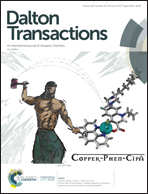Spin crossover in hydrogen-bonded frameworks of FeII complexes with organodisulfonate anions†
Abstract
We present here the syntheses, crystal structures, and thermal and magnetic properties of a series of mononuclear Fe2+ spin crossover (SCO) complexes of the formula [Fe(bamp)2]·Anion·Solv (Anion = NDS2−, Solv = 2H2O, 1NDS; Anion = BPDS2−, Solv = 4.4H2O, 2BPDS; Anion = ABDS2−, Solv = Et2O and H2O, 3ABDS; Anion = DNDS2−, Solv = MeCN, 4DNDS; bamp = 2,6-pyridinedimethanamine, H2NDS = 1,5-naphthalenedisulphonic acid, H2BPDS = 4,4′-biphenyldisulphonic acid, H2ABDS = 4,4′-azobenzenedisulfonic acid, H2DNDS = 4,4′-dinitrostilbene-2,2′-disulfonic acid). The structures and SCO properties of these complexes can be finely modified by organodisulfonate couteranions. Single-crystal X-ray analyses revealed that all these compounds are hydrogen-bonded three-dimensional frameworks constructed from the charge-assisted hydrogen bonds between bamp donors, organodisulfonate acceptors, and/or crystallized solvent molecules. SCO behavior was observed in all four complexes and has been evidenced by detailed structural and magnetic investigations. While 1NDS exhibits a sharp cooperative SCO transition with a transition temperature T1/2 of 247 K, 2BPDS, 3ABDS, and 4DNDS undergo more gradual SCO transitions with T1/2 values of 176, 171 and 158 K, respectively. Magneto-structural relationship studies revealed that the tunable SCO properties, including the trend of the transition temperatures and the cooperativity of the SCO transition, are mainly attributable to the size of the organodisulfonate anions. This study shows that in order to exhibit cooperative SCO properties, “efficient” hydrogen bonds directly connecting the SCO centers, rather than those between the SCO centers and the innocent neighboring groups, are preferred.



 Please wait while we load your content...
Please wait while we load your content...